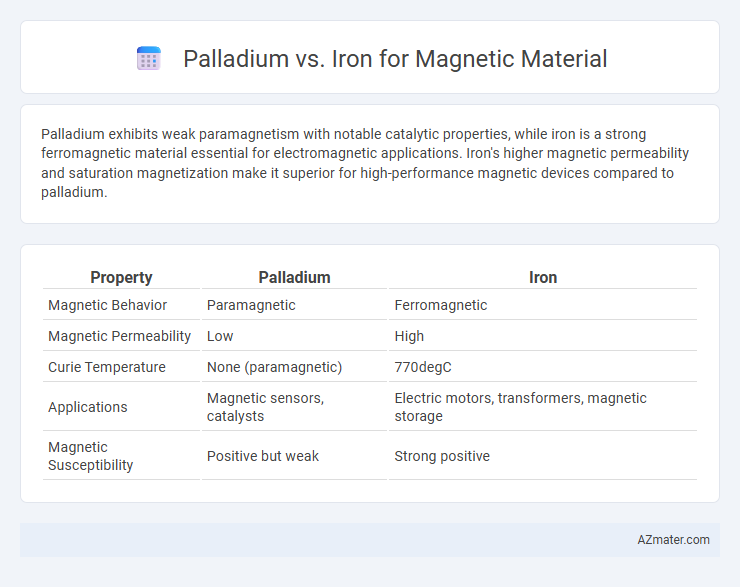Palladium exhibits weak paramagnetism with notable catalytic properties, while iron is a strong ferromagnetic material essential for electromagnetic applications. Iron's higher magnetic permeability and saturation magnetization make it superior for high-performance magnetic devices compared to palladium.
Table of Comparison
| Property | Palladium | Iron |
|---|---|---|
| Magnetic Behavior | Paramagnetic | Ferromagnetic |
| Magnetic Permeability | Low | High |
| Curie Temperature | None (paramagnetic) | 770degC |
| Applications | Magnetic sensors, catalysts | Electric motors, transformers, magnetic storage |
| Magnetic Susceptibility | Positive but weak | Strong positive |
Introduction to Magnetic Materials
Palladium and iron differ significantly in their magnetic properties, with iron being ferromagnetic and widely used in magnetic applications due to its strong magnetic permeability and high Curie temperature around 770degC. Palladium, on the other hand, is paramagnetic, exhibiting weak magnetism only in the presence of an external magnetic field, and is not suitable for permanent magnetic materials. Iron's crystal structure and electron configuration facilitate spontaneous magnetization, making it a primary material in transformers, inductors, and magnetic storage devices compared to palladium's limited role in magnetic uses.
Overview of Palladium and Iron
Palladium is a rare, precious metal known for its excellent catalytic properties and moderate susceptibility to magnetism only when alloyed or subjected to specific conditions. Iron is a widely abundant ferromagnetic metal, exhibiting strong magnetic properties at room temperature due to its unpaired electrons and crystal structure. While iron is a primary material in magnetic applications, palladium's role is often limited to enhancing magnetic alloys or serving in specialized electronic components.
Magnetic Properties of Palladium
Palladium exhibits weak paramagnetism due to its nearly filled d-electron band, which contrasts sharply with iron's strong ferromagnetism and high magnetic permeability. Unlike iron, palladium lacks spontaneous magnetization but shows enhanced susceptibility when alloyed or subjected to external magnetic fields. Its unique electronic structure enables palladium to be used in specialized catalytic and magnetic sensing applications where minimal magnetic interference is crucial.
Magnetic Properties of Iron
Iron exhibits strong ferromagnetic properties due to its unpaired 3d electrons, making it highly responsive to magnetic fields. Its high magnetic permeability and significant saturation magnetization enable efficient magnetic domain alignment, which is critical in electric motors, transformers, and magnetic storage devices. Unlike palladium, which is paramagnetic and exhibits only weak, temporary magnetization, iron maintains permanent magnetization essential for robust magnetic applications.
Electronic Structure Comparison
Palladium and iron exhibit distinct electronic structures influencing their magnetic properties; palladium has a nearly filled 4d electron band resulting in paramagnetism, whereas iron's 3d band is partially filled with localized electrons leading to strong ferromagnetism. The increased density of states at the Fermi level in iron favors exchange splitting and spontaneous magnetization, contrasted with palladium's stable electronic configuration suppressing long-range magnetic ordering. This difference in d-electron occupancy and band structure directly impacts their respective magnetic susceptibilities and applications in magnetic materials.
Applications in Magnetics Technology
Palladium exhibits paramagnetic properties with high magnetic susceptibility, making it suitable for sensitive magnetic sensors and spintronic devices, whereas iron's strong ferromagnetic nature is ideal for core components in transformers, inductors, and electric motors. In magnetics technology, iron's high saturation magnetization and low coercivity enable efficient magnetic flux conduction and energy conversion, while palladium's unique electron configuration supports advanced applications in magnetic recording and magnetic resonance imaging (MRI) contrast agents. The choice between palladium and iron depends on the specific requirements for magnetic strength, sensitivity, and operational stability in devices like magnetic memory, sensors, and power electronics.
Performance in Industrial Use
Palladium exhibits superior corrosion resistance and stable magnetic properties, making it ideal for precision sensors and high-frequency components in industrial applications. Iron offers higher magnetic permeability and saturation magnetization, which enhances its performance in heavy-duty transformers, inductors, and electromagnets. The choice between palladium and iron depends on the balance between durability under harsh conditions and magnetic efficiency required in specific industrial environments.
Cost and Availability Analysis
Palladium is significantly more expensive than iron due to its rarity and extraction costs, making iron the more cost-effective choice for widespread magnetic applications. Iron is abundantly available and widely distributed in the Earth's crust, ensuring a stable supply chain and low material costs for manufacturing. The high price and limited availability of palladium restrict its use primarily to specialized industries rather than bulk magnetic material applications.
Environmental Impact Considerations
Palladium exhibits lower environmental impact during extraction compared to iron, as its mining processes generate fewer toxic byproducts and require less land disruption. Iron production, while more abundant and cheaper, often results in significant CO2 emissions and habitat destruction due to large-scale open-pit mining. Sustainable magnetic material development favors palladium alloys for reducing ecological footprint but must balance high cost and resource scarcity.
Conclusion: Choosing Between Palladium and Iron
When choosing between palladium and iron for magnetic materials, iron remains the preferred option due to its strong ferromagnetic properties and widespread availability, making it ideal for applications requiring high magnetic permeability and cost-effectiveness. Palladium exhibits weak paramagnetism and is significantly more expensive, limiting its use primarily to specialized applications like catalytic converters or electronic components where magnetic strength is less critical. For magnetic device manufacturing, iron's superior magnetic performance and economic advantage make it the optimal material choice.

Infographic: Palladium vs Iron for Magnetic Material
 azmater.com
azmater.com